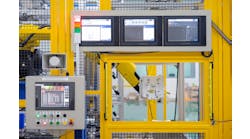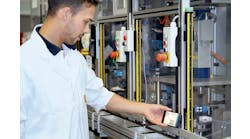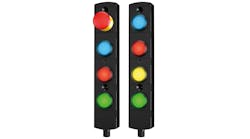Data exists everywhere. How do robots leverage that data via the Industrial Internet of Things (IIoT)? With robotics playing such a pivotal role in the future of discrete manufacturing, we asked a seasoned panel of industry experts for their insights and predictions on the role of robots.
Click here to meet the panel of experts.
Q: The IIoT promises to facilitate communication between equipment everywhere. Examples of 24/7 autonomous plants exist, but will the IIoT eventually enable robots to modify engineering capacity at facilities to meet real-time production demands?
Garrett Place: The ability to modify the engineering capacity requires both data and intelligent algorithms. The good news is that most of the data already exists from the high-level controllers all the way down to the simple on/off sensors. The seamless collection of this data has been the challenge to date. This challenge, however, is being overcome through the proliferation of smarter sensors—better microprocessors—and easy methods for data collection, such as I/O-Link. Both of these items allow the data to be easily collected and evaluated by intelligent algorithms. The result is a smarter robot with the ability to adapt to differing business requirements on the fly.
Scott Mabie: Collaborative robots lend themselves quite naturally as an ideal hub for IoT systems due to their computing power and connectivity, for example, in collecting data about the manufacturing process or in product testing. A recent example of the latter comes from Scott Fetzer Electrical Group (SFEG) in Nashville, Tennessee, where our robots are used for lifecycle testing of new designs. A small motor manufactured at SFEG is placed in the customer product. The robot turns the product’s switch on and off, runs it for a minute on and 30 seconds off for the next 400 hours. The robot collects data pertinent to the test such as maximum Amperage, average Amperage and the number of cycles completed, transmitting that data to a data storage.
Also read: The impact of wireless technology on presence sensors with robots
Putting knowledge back in the factory floor will perhaps be the best long-term result derived from leveraging collaborative robots. The industrial revolution has created enormous wealth, but, at the same time, it has removed passion and knowledge about the product from production itself. If we can close that gap again—if we can somehow mix people and machines in the right way in the factory floor—I see enormous potential there for value adding, rather than just cranking up production levels. It’s qualitative change.
Corey Ryan: Many collaborative robots can be taught new tasks by hand and save that programming directly to the controller. As facilities try to be more flexible, they want the ability to modify application programs on the shop floor and from engineering teams located globally. The ability now exists to do both with relative ease, but I think we have a while to go before the manufacturing community accepts remote changes without a human on site to double-check the end results. There are still a lot of variables in the manufacturing environment that can impact implementations so the IIoT will have to develop new strategies that can both simulate and then test any implementations done remotely.
David Arens: Robots are already being used to service other robots, Why do I need a tip-dressing station at every robot welder? Why don't I make a robot that moves around and does the tip-dressing as needed? I have no doubt that analytics and path optimization and size optimization will all combine to relocate, readjust and modify production lines in the future.
In the past, we moved the parts around and kept different machines in different parts of the factory, but this takes up floor space Why can’t we design a floor plate connection system that you put the machine on top of, and then it’s told which machines are upstream and downstream and where to pick and place parts to and from with the collaborative design activity (COLLADA) 3D description format and then put the production machines in the warehouse and only make what we need when we need it? This would require standardization in communication, format of part transfer and size and interfacing of an automation cell that must be set up to be rugged enough to be transported and to self-level and quality-check its own incoming and outgoing product.
There are already examples of production plants switching out machinery in the automotive tool and die changeout for part production, but there are many industries that could be adaptable in their manufacturing layout and could leverage this process in concept, from order reception to product delivery—thus, the 3D printing and additive manufacturing movement right now. Don't wait for the perfect shape of earphone; make one yourself and customize it right on the spot for your ear and the device connection.
3D scanning and customer-specific production will usher in the next wave of personalization.
Michael Hannah: In this IIoT era, the use of the Internet- and Ethernet-enabled devices is rising. Connected systems will be able to interact with one another, analyze data to predict failure, configure themselves and adapt to changes within the manufacturing process itself. Robots are becoming self-aware and system-aware. This is going to define a new class of advanced robotics—robots with enhanced senses, dexterity and intelligence. They will be able to perform tasks without being pre-programmed as they can learn from experience, from each other and from their environment. These smart machines and robots are the foundation of smart manufacturing. They create factories that are capable of managing complex products and demands, are less prone to disruption and are able to manufacture goods more efficiently.
In these smart factories, human beings, machines and resources will communicate with each other as naturally as humans do today. Robots and machines will not only help to drive productivity improvements in the factory of the future, but they will also be safer for the people around them.
Homepage image courtesy of Master isolated images at FreeDigitalPhotos.net




